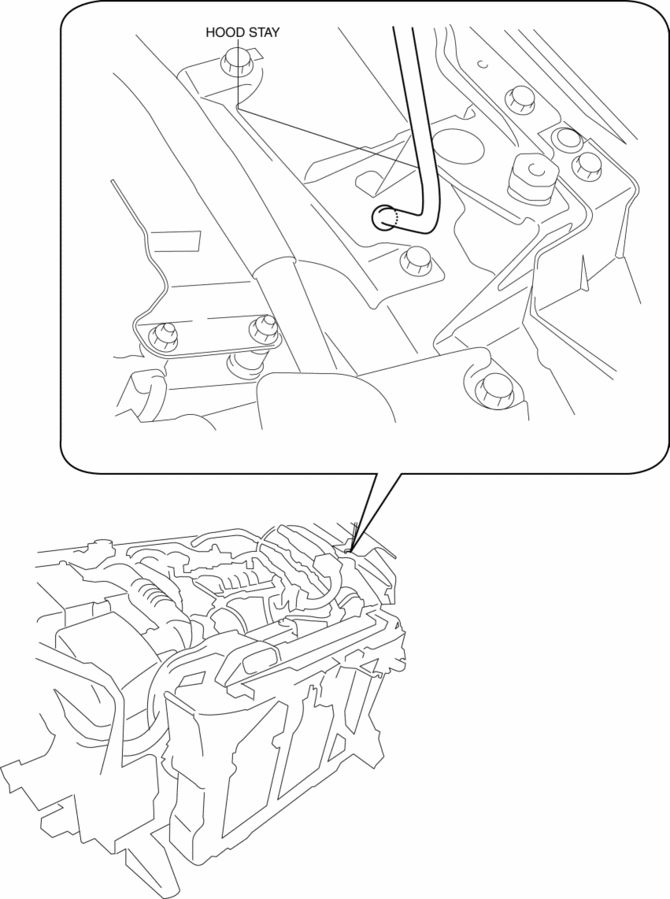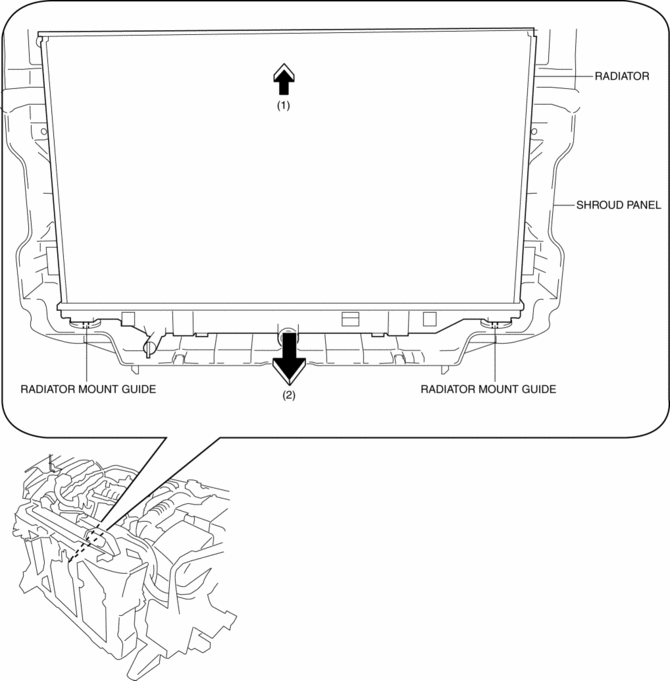Mazda CX-5 Service & Repair Manual: Shroud Panel Removal/Installation
CAUTION:
-
Since the servicing is performed with the hood open, secure the hood using a piece of wood to prevent it from falling.
1. Disconnect the negative battery cable..
2. Remove the following parts:
a. Seal board upper.
b. Front bumper.
c. Front combination light.
d. Shroud upper member.
e. Set plate.
f. Energy-absorbing form.
g. Front under cover No.1.
h. Bumper stiffener lower.
3. Support the shroud panel using a jack.
CAUTION:
-
Because the shroud panel is installed to the bumper reinforcement, support the shroud panel using a jack before removing the bumper reinforcement so as not to apply excessive force to the shroud panel.

4. Remove the following parts:
a. Front bumper reinforcement.
b. Seal plate.
c. Hood latch.
d. Crash zone sensor.
e. Ambient temperature sensor.
f. Horn.
g. Air cleaner cover.
5. Remove clips A.

6. Remove the hood stay from the shroud panel, wrap the hood stay with protective tape, and install it as shown in the figure to support the hood.

7. Pull up the radiator in the direction of the arrow (1) shown in the figure.
CAUTION:
-
Removing the shroud panel without supporting it could cause the shroud panel to fall and cause serious injury. Always perform the procedure with at least another person to prevent the shroud panel from falling.

8. Pull down the shroud panel in the direction of the arrow (2) shown in the figure, then remove it from the radiator mount guide.
9. Remove the shroud panel in the direction of the arrow (3) shown in the figure.

CAUTION:
-
Support the lower surface of the radiator with a jack to prevent the radiator from falling off after the shroud panel is removed.

10. Install in the reverse order of removal.
11. Perform the headlight aiming procedure..
 Radiator
Radiator
Purpose, Function
The radiator disperses the engine coolant heat flowing internally by receiving
against the vehicle while it is driven or air flow produced by the cooling fan.
Constru ...
 Shroud Side Member Installation [Panel Replacement]
Shroud Side Member Installation [Panel Replacement]
Symbol Mark
Installation Procedure
1. When installing new parts, measure and adjust the body as necessary to conform
with standard dimensions.
2. Drill holes for the plug welding before inst ...
Other materials:
Crankshaft Position (CKP) Sensor Removal/Installation
CAUTION:
When foreign material such as an iron chip is on the CKP sensor, it can cause
abnormal output from the sensor because of flux turbulence and adversely affect
the engine control. Be sure there is no foreign material on the CKP sensor when
replacing.
Do not assemble t ...
Hood Latch And Release Lever Removal/Installation
Hood Latch
1. Open the hood.
2. Disconnect the negative battery cable..
3. Remove the front bumper..
4. Insert a tape-wrapped flathead screwdriver into the position shown in the
figure.
5. Move the tape-wrapped flathead screwdriver in the direction of arrow (1) shown
in the figure t ...
Power Window System Preliminary Inspection [Power Window System]
Manual Open/Close Function Inspection
STEP
INSPECTION
ACTION
1
Switch the ignition ON (engine off or on).
Operate the power window using the manual open/close function on
the power window main swit ...
